A Novel Method for Regional Prospecting Based on Modern 3D Graphics
Abstract
1. Introduction
2. Background and Related Work
2.1. Real-Time 3D Visualization
2.2. Programmable Pipeline for Real-Time 3D Rendering
- Transformation and lighting. Here, vertices are transformed into camera space through model–view–projection (MVP) matrices. Then, for each vertex, a Blinn–Phong model is used to calculate the lighting of each vertex, which is called “per-vertex lighting” (Figure 1c);
- Primitive assembly. According to the vertex sequence specified by the application, the vertices are connected to the surfaces of triangles, which become faces or bodies with a polygonal topology structure (Figure 1c);
- Rasterization. Each triangle made in the last stage is rasterized into pixels. For each pixel, the Gouraud shading algorithm is used to interpolate the lighting and UV coordinates of vertices around each pixel. At this stage, the per-vertex data become per-pixel data (Figure 1d);
- Texture mapping. Diffuse textures provided by the application are sampled according to the UV coordinates of each pixel. Then, at each pixel, the diffuse color multiplies the lighting to obtain the final color (Figure 1f).
| Line 0 | if (a < b) { |
| Line 1 | a * b; |
| Line 2 | } else { |
| Line 3 | a + b; |
| Line 4 | } |
2.3. Tiled Web Map
3. A Novel Prospecting Evaluation Method
3.1. Dynamic Geochemical Maps (DGMs)
- We created a single-channel float format TIFF image with an aspect ratio equal to the Zhunuo ore district map’s frame with a maximum length of 512 pixels. The four corners of the image had corresponding geographic spatial coordinates that could be deduced from the ore district map. Here, we call this image the DATA.
- We used the inverse distance weight method to interpolate the Cu value to each pixel in this image, so each pixel stored the value at the spatial position to which each pixel corresponded, as shown in Figure 7b.
- We generated a 3-channel (RGB) 8-bit format image with a height of 1 pixel and a width of 1024 pixels and filled this image with a gradient of rainbow using OpenCV, as shown in Figure 7c. Here, we call this image the PALETTE.
- We loaded the above two images as textures into the video memory and used them in the rasterization layers of Cesium for Unreal.
- To render the DATA texture into the correct spatial position, an algorithm called “inverse bilinear interpolation” was used and is explained in detail later. In this step, the spatial position of every pixel in the DATA was determined by computing the UV coordinates of each pixel on the 3D globe for sampling the DATA.
- In the material of the rasterization layers of Cesium for Unreal, after sampling the DATA with the UV coordinates from the last step, the sampling value had to be transformed with the following algorithm to clamp and normalize, as follows:
- Let , calculate , where is the sampling value, is the lower anomaly limit from the user input, and is the upper anomaly limit from the user input.
- Use as the UV coordinates to sample the PALETTE, and then output the sampling color.
- Because GPUs can reflect changes in real time, by inputting different m and n, the upper and lower anomaly limits can be tuned in real time. As shown in Figure 7d,f using a different m and n resulted in different visualizations in Figure 7e,g. Each result was generated in less than 10 milliseconds on a GeForce RTX 3070 GPU.
3.2. Interactive Geological Map (IGM)
- 2.
- We rasterized the lithology regions in the vector geological map. During the rasterization process, the RGB colors were written into the image’s RGB channel, and the region numbers from the enumeration were written into the alpha channel, as shown in Figure 8(b-1,b-2). All four channels were in unsigned int-8 format. Here, we call this image the DATA.
- 3.
- The map region of Zhunuo is a convex quadrilateral but not a rectangle, and GPU rendering requires that textures must be rectangular. Therefore, the DATA had to be perspective-corrected and clipped in OpenCV to fill an entire rectangular image, just like the DGM we just created.
- 4.
- As we mentioned above, the visibility of the lithology regions must be controllable separately. To achieve this, the application procedurally created an image with a width of 256 pixels, as each pixel corresponded to a type of lithology, as shown in Figure 8c. Here, we call this image the LUT. Users can control the visibility by changing the values of these pixels. For example, if the user wants to make “monzonite porphyry” visible, which has a numbering of two according to Table 2, they can simply set the third pixel from the left of the LUT, whose index is two in a zero-based numbering, to a value of 1.0 in a linear space (which is 255 in a non-linear unsigned int-8 space). In contrast, it needs to be set to 0.0 if the user wants to make it invisible.
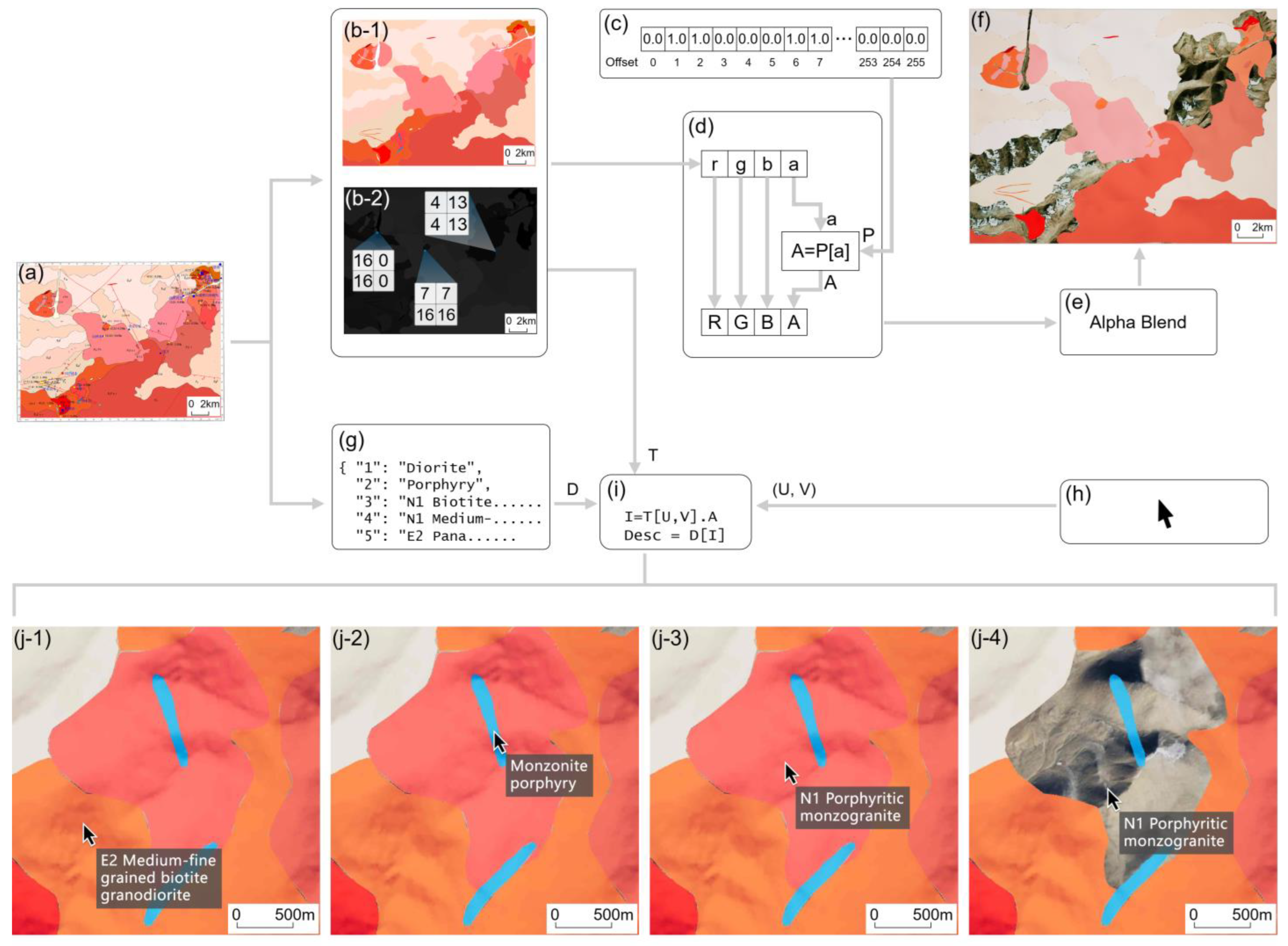
- 5.
- We loaded the DATA and the LUT as textures into the video memory and used them in the rasterization layers of Cesium for Unreal. Just like the DGM, to render the DATA in the correct spatial position, we needed to compute the UV coordinates of each pixel on the 3D globe for sampling the DATA using “inverse bilinear interpolation” too, which is explained in detail later.
- 6.
- In the material of the rasterization layers of Cesium for Unreal, after sampling the DATA with the UV coordinates from last step, a four-component array representing RGBA color in the linear space was obtained. Among them, A represents the numbering of the lithology corresponding to the pixel, which is also the U component of the UV coordinates to sample the visibility of this lithology type in the LUT. If the sampling value from the LUT is greater than 0.0, then the sampling color from the DATA is the RGB component output. Otherwise, the color is output in the next layer, as this specified lithology is invisible, as shown in Figure 8d–f.
- 7.
- To interactively query the lithology description at each place, the 3D world coordinates corresponding to the mouse cursor on the 3D terrain must be acquired first. Here, again, we used “inverse bilinear interpolation” to calculate the UV coordinates of the cursor position relative to the four corners of the IGM. On the CPU side of the application, we used these UV coordinates to sample the DATA to obtain the lithology numbering at the position, just like on the GPU side. With the lithology numbering, we queried the key-value map in the JSON format we made above to obtain the lithology description, as shown in Figure 8(j-1–j-4).
3.3. Inverse Bilinear Interpolation
3.4. Composition of Bitmaps
4. Practice in the Zhunuo Ore District
5. Discussion
6. Conclusions
Author Contributions
Funding
Data Availability Statement
Acknowledgments
Conflicts of Interest
References
- Carranza, E.J.M. Geochemical Anomaly and Mineral Prospectivity Mapping in GIS; Elsevier: Amsterdam, The Netherlands, 2008. [Google Scholar]
- Zuo, R.; Carranza, E.J.M.; Wang, J. Spatial analysis and visualization of exploration geochemical data. Earth Sci. Rev. 2016, 158, 9–18. [Google Scholar] [CrossRef]
- Zuo, R.; Wang, J.; Xiong, Y.; Wang, Z. The processing methods of geochemical exploration data: Past, present, and future. Appl. Geochem. 2021, 132, 105072. [Google Scholar] [CrossRef]
- Cheng, Z.; Xie, X.; Yao, W.; Feng, J.; Zhang, Q.; Fang, J. Multi-element geochemical mapping in Southern China. J. Geochem. Explor. 2014, 139, 183–192. [Google Scholar] [CrossRef] [PubMed]
- Cheng, Q. Spatial and scaling modelling for geochemical anomaly separation. J. Geochem. Explor. 1999, 65, 175–194. [Google Scholar] [CrossRef]
- Desktop GIS Software. Available online: https://www.esri.com/en-us/arcgis/products/arcgis-pro/overview (accessed on 15 March 2024).
- Yin, B.; Zuo, R.; Xiong, Y.; Li, Y.; Yang, W. Knowledge discovery of geochemical patterns from a data-driven perspective. J. Geochem. Explor. 2021, 231, 106872. [Google Scholar] [CrossRef]
- Nowak, M.M.; Dziób, K.; Ludwisiak, Ł.; Chmiel, J. Mobile GIS applications for environmental field surveys: A state of the art. Glob. Ecol. Conserv. 2020, 32, e01089. [Google Scholar] [CrossRef]
- Global Mapper. Available online: https://www.bluemarblegeo.com/global-mapper/ (accessed on 15 March 2024).
- Image Processing & Analysis Software. Available online: https://www.nv5geospatialsoftware.com/Products/ENVI (accessed on 15 March 2024).
- Xing, Y.; Gomez, R.B. Hyperspectral image analysis using ENVI (environment for visualizing images). In Proceedings of the SPIE—The International Society for Optical Engineering, Orlando, FL, USA, 16–20 April 2001. [Google Scholar] [CrossRef]
- Zuo, R.; Yin, B. Google Earth-aided visualization and interpretation of geochemical survey data. Geochem. Explor. Environ. Anal. 2022, 22, 125959. [Google Scholar] [CrossRef]
- Earth Versions—Google Earth. Available online: https://www.google.com/earth/about/versions/ (accessed on 15 March 2024).
- Ovital Interactive Map (In Chinese). Available online: https://www.ovital.com/download/ (accessed on 15 March 2024).
- Asano, S.; Maruyama, T.; Yamaguchi, Y. Performance comparison of FPGA, GPU and CPU in image processing. In Proceedings of the 2009 International Conference on Field Programmable Logic and Applications, Prague, Czech Republic, 31 August–2 September 2009. [Google Scholar] [CrossRef]
- Zheng, Y.; Gao, S.; Zhang, D.; Fan, Z.; Zhang, G.; Ma, G. The discovery of the Zhunuo porphyry copper deposit in Tibet and its significance. Earth Sci. Front. 2006, 13, 233–239. (In Chinese) [Google Scholar]
- Zheng, Y.; Sun, X.; Gao, S.; Wang, C.; Zhao, Z.; Wu, S.; Li, J.; Wu, X. Analysis of stream sediment data for exploring the Zhunuo porphyry Cu deposit, southern Tibet. J. Geochem. Explor. 2014, 143, 19–30. [Google Scholar] [CrossRef]
- Google Maps Tile API. Available online: https://developers.google.com/maps/documentation/tile (accessed on 15 March 2024).
- Harrell, J.A.; Brown, V.M. The World’s oldest surviving geological map: The 1150 BC Turin Papyrus from Egypt. J. Geol. 1992, 100, 3–18. [Google Scholar] [CrossRef]
- Blackborow, J. Digital Experiences in the Physical World; Forrester: Cambridge, MA, USA, 2020. [Google Scholar]
- Kontkanen, J. Novel Illumination Algorithms for Off-Line and Real-Time Rendering. Ph.D. Thesis, Helsinki University of Technology, Helsinki, Finland, 9 February 2007. [Google Scholar]
- Eevee vs. Cycles (CPU Rendering) Comparison on a Mac. Available online: https://blenderartists.org/t/eevee-vs-cycles-cpu-rendering-comparison-on-a-mac/1275653 (accessed on 15 March 2024).
- Hadwiger, M. 3D Graphics Technology in Computer Games Past, Present, and Future. In Proceedings of the 4th Central European Seminar on Computer Graphics, Budmerice, Slovakia, 3 May 2000. [Google Scholar]
- Holmåker, M.; Woxblom, M. Performance evaluation of the fixed function pipeline and the programmable pipeline. Master’s Thesis, Blekinge Institute of Technology, Blekinge, Sweden, 24 June 2004. [Google Scholar]
- Nickolls, J.; Dally, W.J. The GPU computing era. IEEE Micro. 2010, 30, 56–69. [Google Scholar] [CrossRef]
- Cypher, R.; Sanz, J.L. SIMD architectures and algorithms for image processing and computer vision. IEEE Trans. Acoust. Speech. Signal. Process. 1989, 37, 2158–2174. [Google Scholar] [CrossRef]
- Thaler, J. Deferred Rendering; TU Wein: Vienna, Austria, 2011. [Google Scholar]
- Krüger, J.; Westermann, R. Linear algebra operators for GPU implementation of numerical algorithms. In Proceedings of the ACM SIGGRAPH 2005 Courses, Los Angeles, CA, USA, 4 August 2005. [Google Scholar] [CrossRef]
- Fisher, T.; MacDonald, C. An Overview of the Canada Geographic Information System (CGIS); Lands Directorate Environment Canada: Ottawa, ON, Canada, 1980. [Google Scholar]
- Crampton, J.W. Keyhole, Google Earth, and 3D Worlds: An Interview with Avi Bar-Zeev. Cartogr. Int. J. Geogr. Inf. Geovis. 2008, 43, 85–93. [Google Scholar] [CrossRef]
- García, R.; de Castro, J.P.; Verdú, E.; Verdú, M.J.; Regueras, L.M. Web map tile services for spatial data infrastructures: Man-agement and optimization. In Cartography—A Tool for Spatial Analysis; Bateira, C., Ed.; InTech: Rijeka, Croatia, 2012; pp. 26–48. [Google Scholar] [CrossRef]
- Gede, M. Thematic mapping with Cesium. In Proceedings of the 6th International Conference on Cartography and GIS, Albena, Bulgaria, 20–25 June 2016. [Google Scholar]
- Hu, W.; Liu, D.; You, P.; Zhao, J.; Du, H.; Zhang, H. Research on Digital Governance of Rural Environment Based on Cesium for Unreal. In Proceedings of the 1st International Conference on Public Management, Digital Economy and Internet Technology, Changsha, China, 23–25 September 2022. [Google Scholar]
- Ci, Q.; Liu, X.; Zhu, J.; Basang, C.; Jia, C.; Wujian, C.; Xirao, J.; Basang, O.; Dawa, Z. Report of Mineral Prospecting Survey in the Zhunuo Area, Tibet; Geological Survey Bureau: Lhasa, Tibet, China, 2009. (In Chinese) [Google Scholar]
- Inigo Quilez: Computer Graphics, Mathematics, Shaders, Fractals, Demoscene and More. Available online: https://iquilezles.org/articles/ibilinear (accessed on 20 December 2023).
- Zheng, Y.; Zhang, G.; Xu, R.; Gao, S.; Pang, Y.; Cao, L.; Du, A.; Shi, Y. Geochronologic constraints on magmatic intrusions and mineralization of the Zhunuo porphyry copper deposit in Gangdese, Tibet. Chin. Sci. Bull. 2007, 52, 3139–3147. [Google Scholar] [CrossRef]
- Zheng, Y.; Wu, S.; Ci, Q.; Chen, X.; Gao, S.; Liu, X.; Jiang, X.; Zheng, S.; Li, M.; Jiang, X. Cu-Mo-Au Metallogenesis and Minerogenetic Series during Superimposed Orogenesis Process in Gangdese. Earth Sci. 2021, 46, 1909–1940. [Google Scholar] [CrossRef]
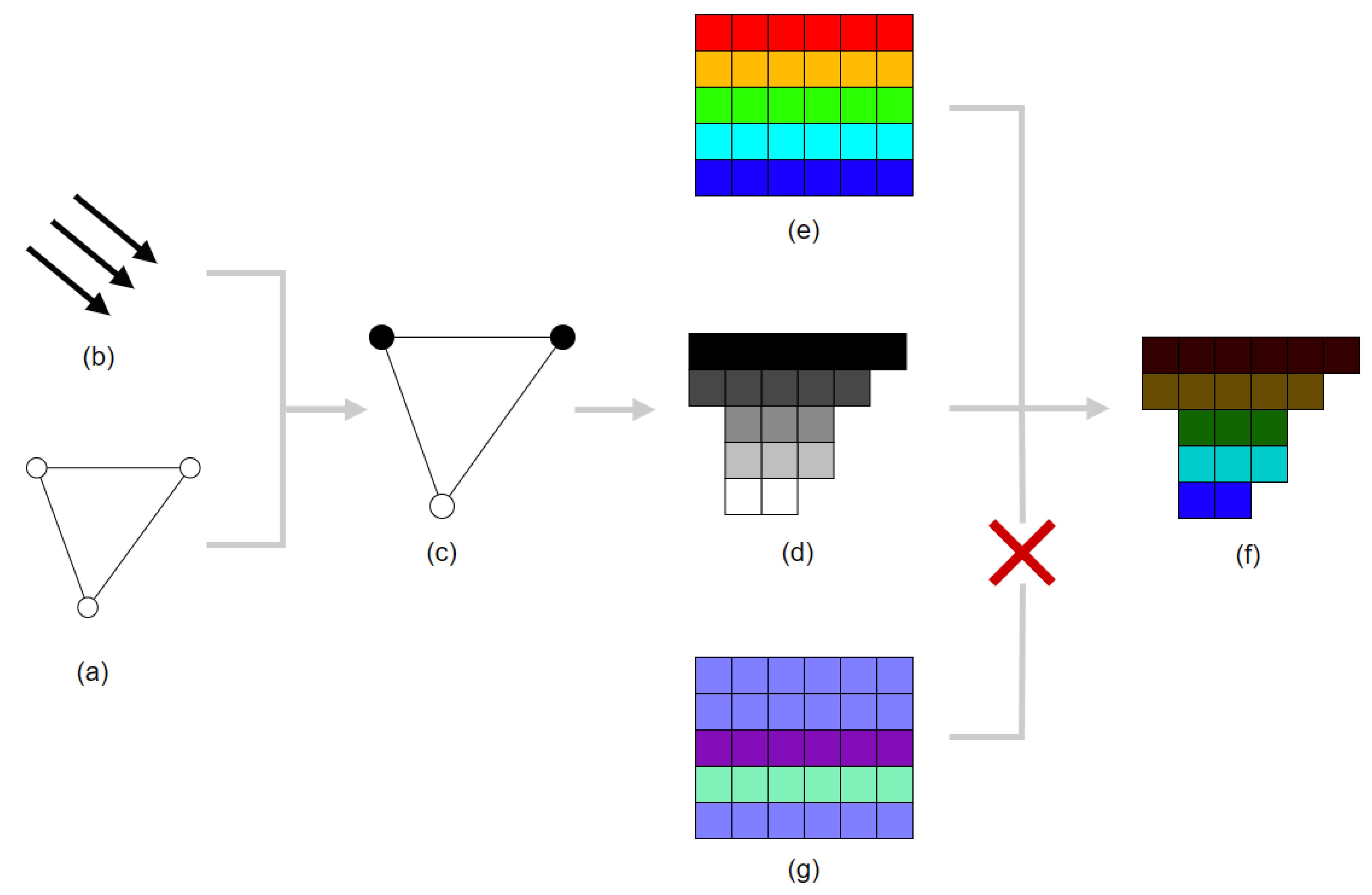
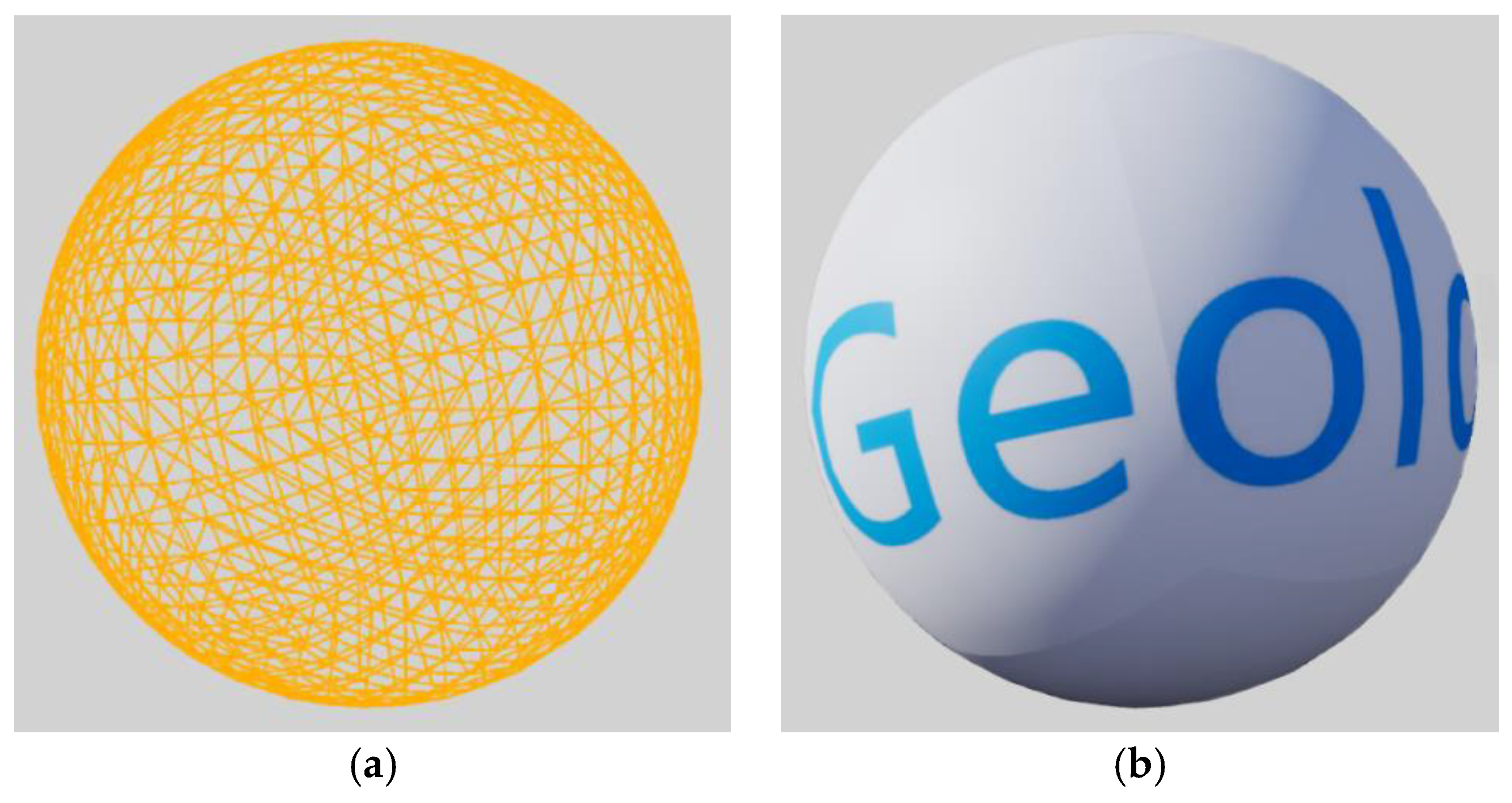
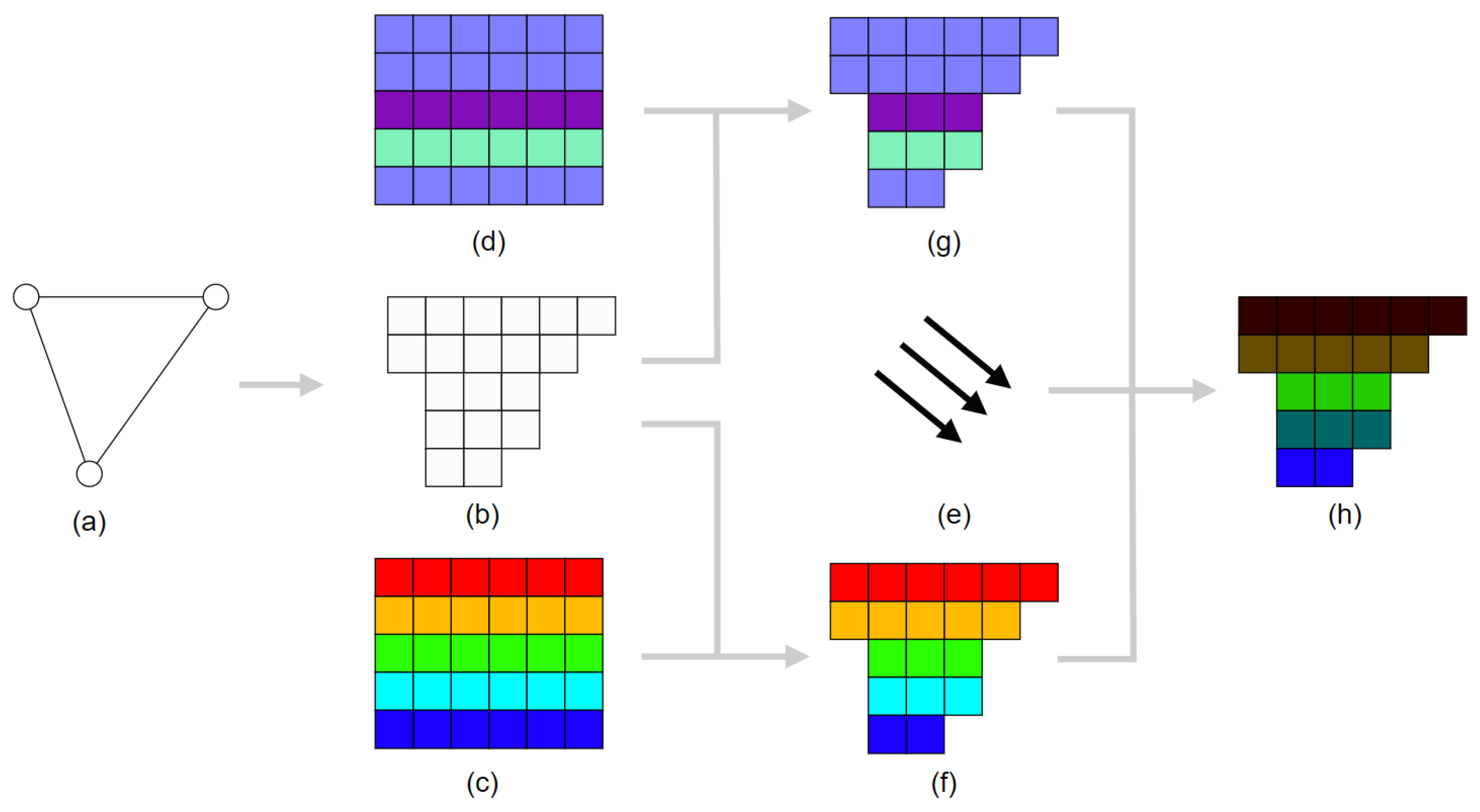

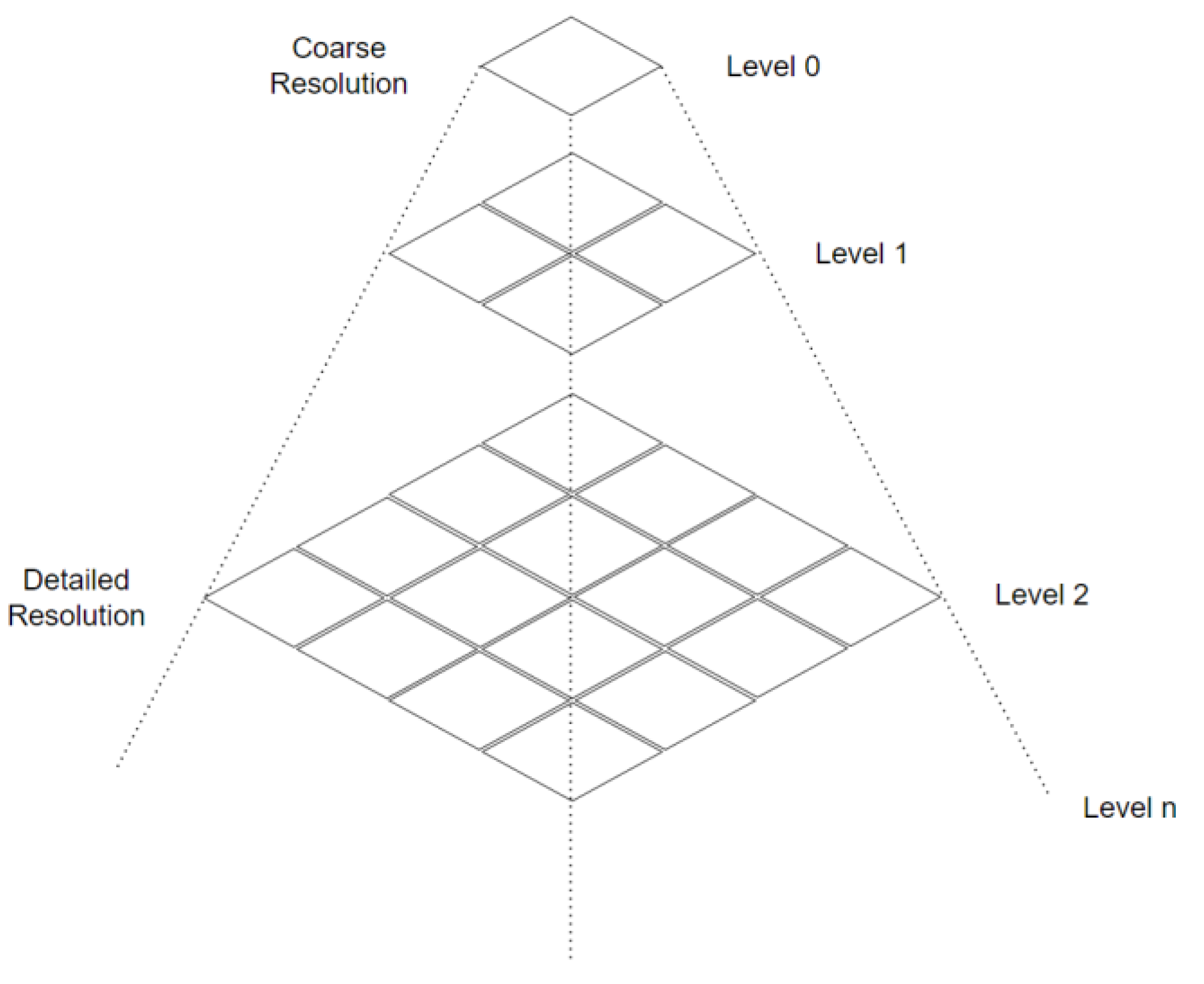

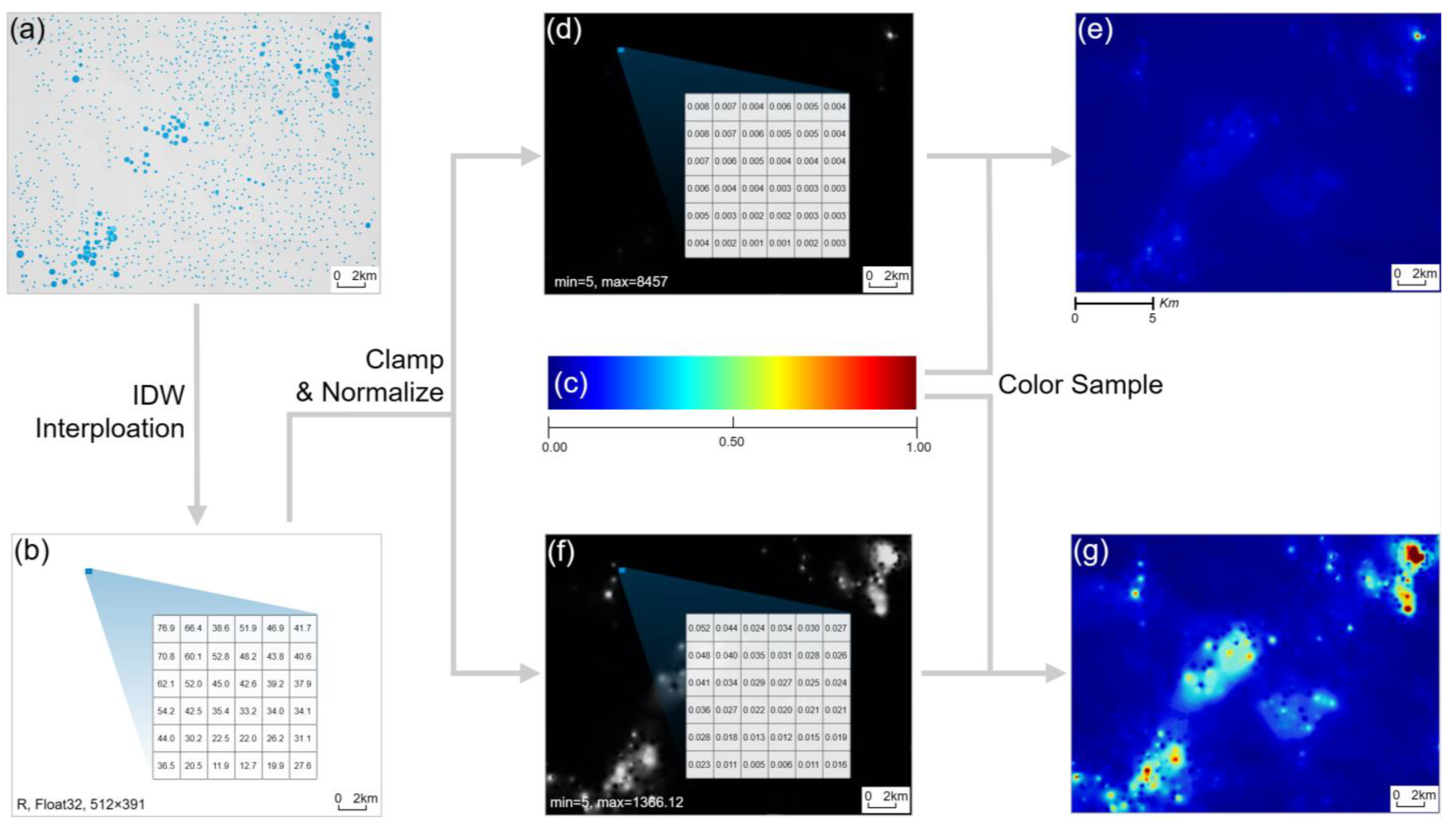
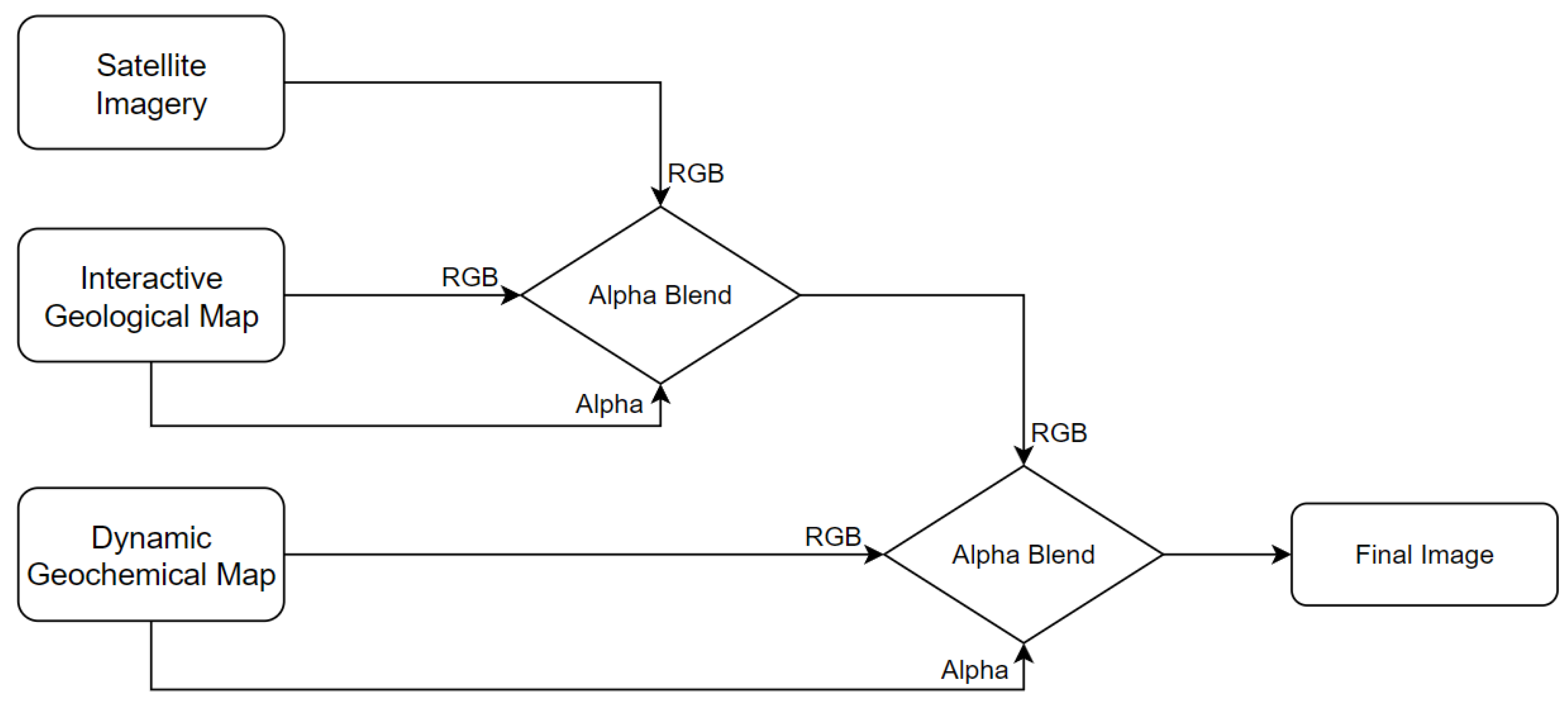
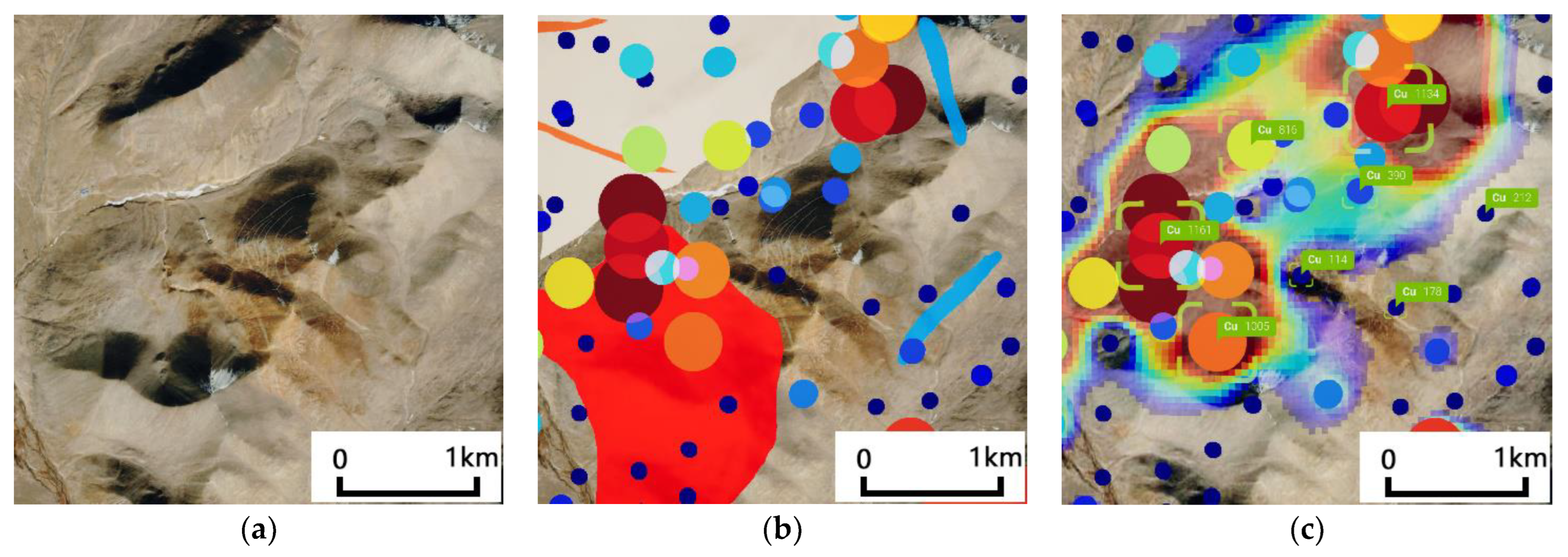
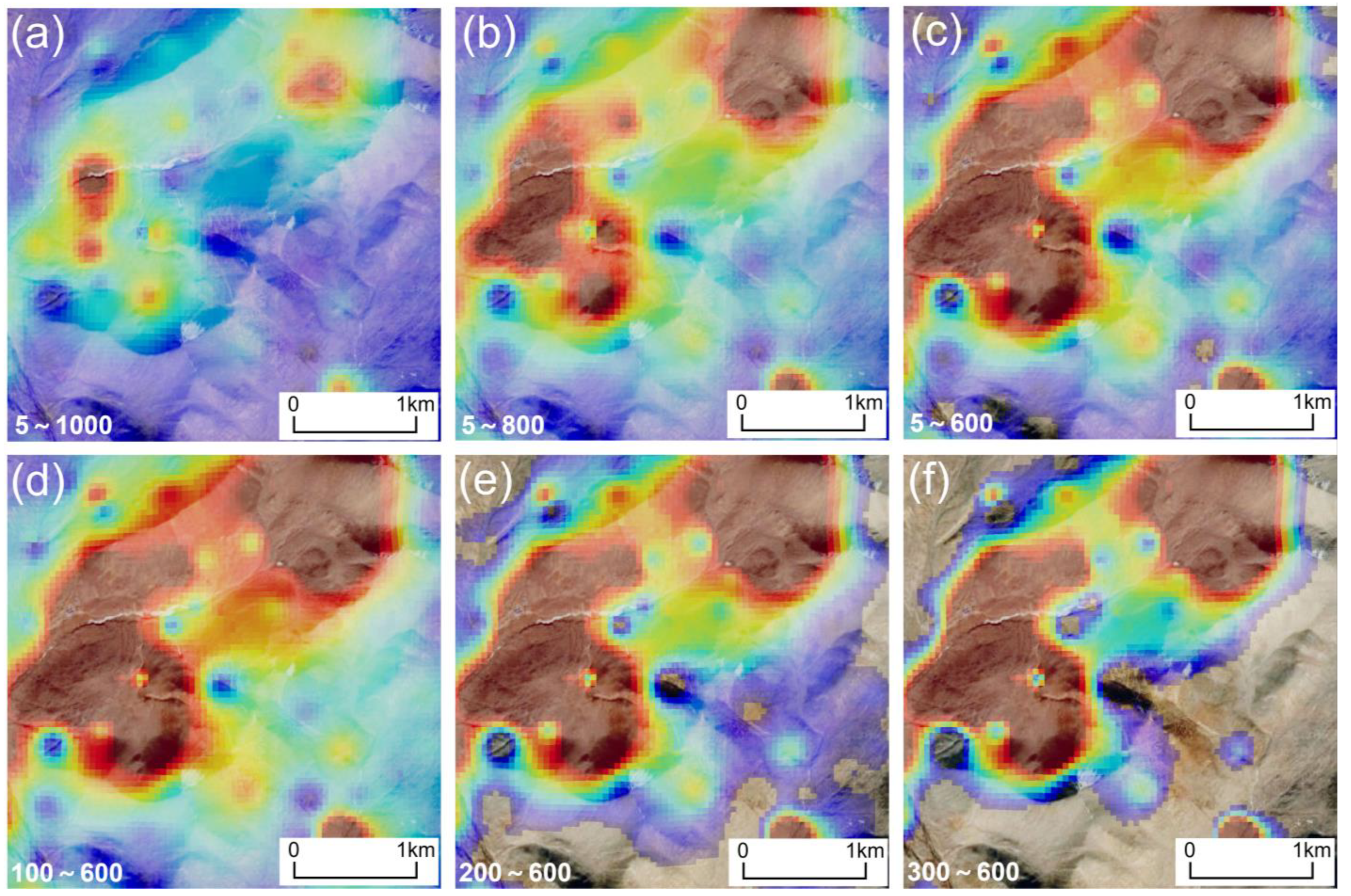
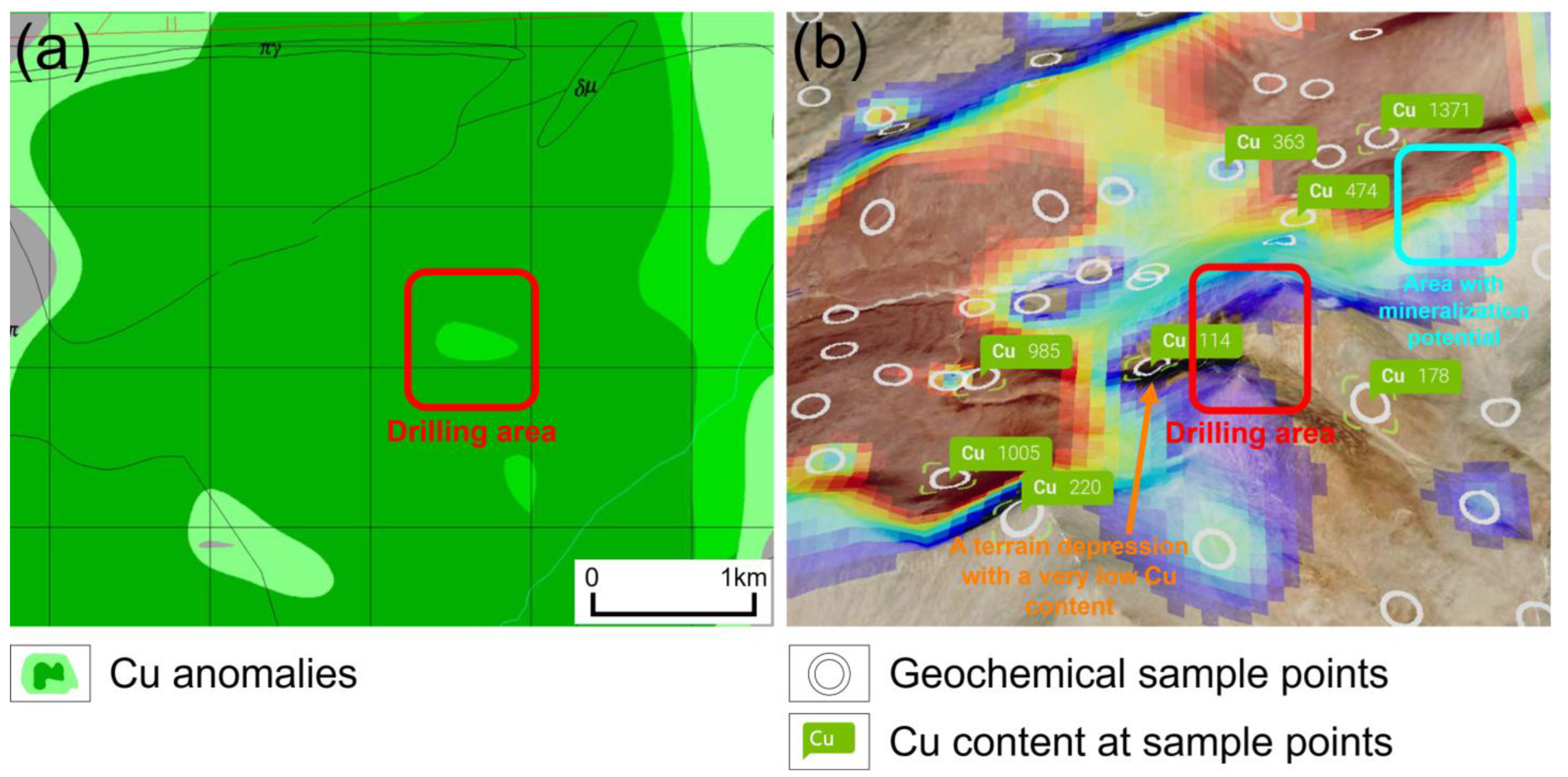
| Element | Cu |
|---|---|
| Number of Samples | 1457 |
| Mean | 0.63 |
| Std | 1.73 |
| CV | 2.75 |
| Median | 0.17 |
| MAD | 0.09 |
| Minimum | 0.03 |
| Maximum | 45.91 |
| 25th percentiles | 0.10 |
| 75th percentiles | 0.42 |
| 95th percentiles | 3.07 |
| 98th percentiles | 5.34 |
| Skewness | 14.08 |
| Kurtosis | 329.54 |
| Number | Lithology Description |
|---|---|
| 1 | Diorite |
| 2 | Monzonite porphyry |
| 3 | N1—Biotite monzogranite porphyry |
| 4 | N1—Medium-coarse-grained porphyritic biotite monzogranite |
| 5 | E2—Upper Pana Formation |
| 6 | E2—Lower Nianbo Formation |
| 7 | N1—Medium-fine-grained porphyritic granite porphyry |
| 8 | E2—Medium-fine-grained biotite granodiorite |
| 9 | E1—Upper Dianzhong Formation |
| 10 | N1—Porphyritic monzogranite |
| 11 | E2—Medium-coarse-grained biotite monzogranite |
| 12 | N1—Medium-coarse-grained porphyritic biotite monzogranite |
| 13 | E2—Medium-fine-grained K-feldspar granite |
| 14 | E2—Upper Pana Formation |
| 15 | E2—Lower Nianbo Formation |
| 16 | N1—Porphyritic monzogranite |
| 17 | E2—Medium-coarse-grained biotite monzogranite |
Disclaimer/Publisher’s Note: The statements, opinions and data contained in all publications are solely those of the individual author(s) and contributor(s) and not of MDPI and/or the editor(s). MDPI and/or the editor(s) disclaim responsibility for any injury to people or property resulting from any ideas, methods, instructions or products referred to in the content. |
© 2024 by the authors. Licensee MDPI, Basel, Switzerland. This article is an open access article distributed under the terms and conditions of the Creative Commons Attribution (CC BY) license (https://creativecommons.org/licenses/by/4.0/).
Share and Cite
Xue, Z.; Wu, S.; Li, M.; Cheng, K. A Novel Method for Regional Prospecting Based on Modern 3D Graphics. Minerals 2024, 14, 354. https://doi.org/10.3390/min14040354
Xue Z, Wu S, Li M, Cheng K. A Novel Method for Regional Prospecting Based on Modern 3D Graphics. Minerals. 2024; 14(4):354. https://doi.org/10.3390/min14040354
Chicago/Turabian StyleXue, Zhaolong, Song Wu, Miao Li, and Kaiwang Cheng. 2024. "A Novel Method for Regional Prospecting Based on Modern 3D Graphics" Minerals 14, no. 4: 354. https://doi.org/10.3390/min14040354
APA StyleXue, Z., Wu, S., Li, M., & Cheng, K. (2024). A Novel Method for Regional Prospecting Based on Modern 3D Graphics. Minerals, 14(4), 354. https://doi.org/10.3390/min14040354






